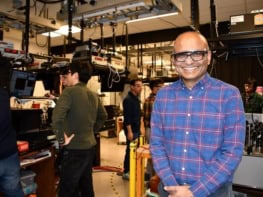
Currents of electron spin can travel more than half a micron through germanium at room temperature, according to researchers in Japan and the UK. While physicists already know that germanium is a good conductor of spins at very low temperatures, this is the best measurement yet of its ability to transport spin at room temperature. The results suggest that the semiconductor could be used to create spintronic devices, which make use of the spin magnetic moment of the electron to store and process information.
The idea of spintronics has been around for several decades, and the nascent technology promises to deliver devices that are smaller and more energy efficient than conventional electronics. Another potential application of spintronics is to use individual electron spins – which can point up or down – to store and transfer information in quantum computers.
However, practical spintronic devices have proven to be very difficult to build, because electron spin does not travel very far in most materials and therefore the information is quickly lost. The main challenge is overcoming a well-known effect in physics called the “spin–orbit interaction”. As the electron travels through a material, the relative motions of the positively charged atoms create magnetic fields that tend to rotate the electron’s spin. In most materials, this results in the rapid destruction of a spin current across very short distances. Fortunately, some semiconductors already used in electronics – including silicon and germanium – have very weak spin–orbit interactions, and so a lot of effort has been put into studying the spin-transport properties of these materials.
Electrical injection
Before you can measure how far a spin current will travel, you have to inject it into a semiconductor, which is not easy to do. One technique involves shining circularly polarized light onto the semiconductor, which tends to spin-polarize the conduction electrons. However, this requires a light source, and is therefore not very practical for miniaturization and mass production of spintronic components. Another option is to place a ferromagnetic material next to the semiconductor so that a spin current can be driven out of the magnet and into the semiconductor. While this “electrical injection” sounds like a great idea, in practice, spin–orbit and other interactions at the interface between the two materials tend to scramble most of the spins before they make it into the semiconductor.
Several studies have suggested that electrical injection should be possible for germanium at room temperature. However, these measurements have not been conclusive because of experimental difficulties. Now, Sergei Dushenko of Osaka University, Masashi Shiraishi of Kyoto University and colleagues have used a microwave “spin-pumping” technique to inject a spin current into germanium.
Their experiment comprises a flat piece of n-doped germanium with a piece of ferromagnetic iron/nickel alloy at one end and a piece of the non-magnetic metal at the other end. An external magnetic field aligns the spins in the alloy along a specific direction. Microwave radiation is then shone onto the alloy, which causes the spins to rotate about the direction of the applied field. This causes a current of spins to be “pumped” into the germanium and flow a short distance to the metal. When the spin current enters the metal, it encounters a strong spin–orbit interaction that creates a voltage across the metal – a phenomenon called the “inverse spin Hall effect”. This voltage is then detected and related to the size of the spin current.
Theory backed up
From these measurements, the team was able to show that the spin current travels about 660 nm before it begins to suffer significant degradation. This applies at room temperature (about 290 K), and when the germanium was cooled down to 130 K, the spin current could travel about twice as far. This backs up a new theory of spin transport that was proposed last year by Yang Song, Oleg Chalaev and Hanan Dery of the University of Rochester in the US.
While 660 nm may not seem like very far, it is much larger than the size of a feature in a modern integrated circuit. In principle, this means that spins could move from one tiny spintronic device to the next without suffering degradation. Furthermore, this distance is on a par with other candidate materials for spin circuits, giving scientists another building block to create spintronic devices.
The research is described in Physical Review Letters.



